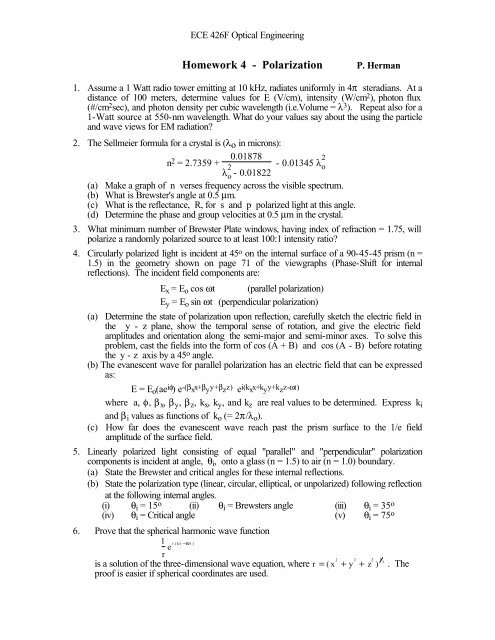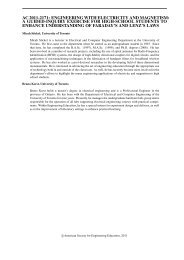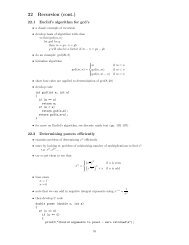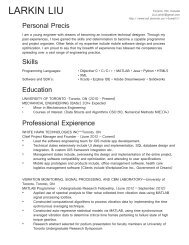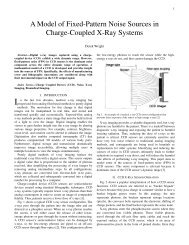Homework 4: Polarization and Fresnel Eqn.
Homework 4: Polarization and Fresnel Eqn.
Homework 4: Polarization and Fresnel Eqn.
Create successful ePaper yourself
Turn your PDF publications into a flip-book with our unique Google optimized e-Paper software.
ECE 426F Optical Engineering<br />
<strong>Homework</strong> 4 - <strong>Polarization</strong><br />
P. Herman<br />
1. Assume a 1 Watt radio tower emitting at 10 kHz, radiates uniformly in 4π steradians. At a<br />
distance of 100 meters, determine values for E (V/cm), intensity (W/cm 2 ), photon flux<br />
(#/cm 2 sec), <strong>and</strong> photon density per cubic wavelength (i.e.Volume = λ 3 ). Repeat also for a<br />
1-Watt source at 550-nm wavelength. What do your values say about the using the particle<br />
<strong>and</strong> wave views for EM radiation?<br />
2. The Sellmeier formula for a crystal is (λo in microns):<br />
n 2 0.01878<br />
= 2.7359 +<br />
λ 2 o - 0.01822 - 0.01345 λ2 o<br />
(a) Make a graph of n verses frequency across the visible spectrum.<br />
(b) What is Brewster's angle at 0.5 µm.<br />
(c) What is the reflectance, R, for s <strong>and</strong> p polarized light at this angle.<br />
(d) Determine the phase <strong>and</strong> group velocities at 0.5 µm in the crystal.<br />
3. What minimum number of Brewster Plate windows, having index of refraction = 1.75, will<br />
polarize a r<strong>and</strong>omly polarized source to at least 100:1 intensity ratio?<br />
4. Circularly polarized light is incident at 45 o on the internal surface of a 90-45-45 prism (n =<br />
1.5) in the geometry shown on page 71 of the viewgraphs (Phase-Shift for internal<br />
reflections). The incident field components are:<br />
E x = E o cos ωt (parallel polarization)<br />
E y = E o sin ωt (perpendicular polarization)<br />
(a) Determine the state of polarization upon reflection, carefully sketch the electric field in<br />
the y - z plane, show the temporal sense of rotation, <strong>and</strong> give the electric field<br />
amplitudes <strong>and</strong> orientation along the semi-major <strong>and</strong> semi-minor axes. To solve this<br />
problem, cast the fields into the form of cos (A + B) <strong>and</strong> cos (A - B) before rotating<br />
the y - z axis by a 45 o angle.<br />
(b) The evanescent wave for parallel polarization has an electric field that can be expressed<br />
as:<br />
E = E o (ae iφ ) e -(β x x+β y y+β z z) e i(k x x+k y y+k z z-ωt)<br />
where a, φ, β x , β y , β z , k x , k y , <strong>and</strong> k z are real values to be determined. Express k i<br />
<strong>and</strong> β i values as functions of k o (= 2π/λ o ).<br />
(c) How far does the evanescent wave reach past the prism surface to the 1/e field<br />
amplitude of the surface field.<br />
5. Linearly polarized light consisting of equal "parallel" <strong>and</strong> "perpendicular" polarization<br />
components is incident at angle, θ i , onto a glass (n = 1.5) to air (n = 1.0) boundary.<br />
(a) State the Brewster <strong>and</strong> critical angles for these internal reflections.<br />
(b) State the polarization type (linear, circular, elliptical, or unpolarized) following reflection<br />
at the following internal angles.<br />
(i) θ i = 15 o (ii) θ i = Brewsters angle (iii) θ i = 35 o<br />
(iv) θ i = Critical angle (v) θ i = 75 o<br />
6. Prove that the spherical harmonic wave function<br />
1<br />
e<br />
i ( kr −ω t )<br />
r<br />
is a solution of the three-dimensional wave equation, where r = ( x 2 + y 2 + z 2 ) 1 2<br />
proof is easier if spherical coordinates are used.<br />
. The
ECE 426F Optical Engineering<br />
7. Derive the formulas<br />
u g<br />
= u − λ du<br />
1<br />
dλ <strong>and</strong> = 1 − λ 0<br />
u g<br />
u c<br />
dn<br />
dλ 0<br />
8. Find the critical angle for internal reflection in water (n = 1.33) <strong>and</strong> diamond (n = 2.42).<br />
9. Find the reflectance for both TE <strong>and</strong> TM polarizations at an angle of incidence of 45<br />
degrees. What is the Brewster angle for external reflection?<br />
10. A beam of light is totally reflected in a 45-90-45-degree glass prism (n = 1.5) as shown<br />
below. The wavelength of the light is 500 nm. At what distance from the surface is the<br />
amplitude of the evanescent wave 1/e of its value at the surface? By what factor is the<br />
intensity of the evanescent wave reduced at a distance of 1 mm from the surface?<br />
11. State the type of polarization (linear, circular, elliptical, etc.) for each case below (sense of<br />
rotation, field orientation, amplitudes are not required):<br />
r<br />
(a) E = E x ˆ e i ( kz−ωt ) i ( kz−ωt +φ )<br />
+ E ′ y ˆ e<br />
(i) E = E ′ , φ = π/2 (ii) E = E ′ , φ = π/4 (iii) E ≠ E ′ , φ = 0<br />
(iv) E ≠ E ′ , φ = π/2 (v) E = E ′ , φ = r<strong>and</strong>om<br />
(b) Assume linear polarized light is incident on a glass-to-air boundary (from glass to air)<br />
with equal strength of the parallel <strong>and</strong> perpendicular polarization fields. Assume n = 1.5<br />
for glass.<br />
(i) reflection for θ i = 15 o<br />
(ii) reflection for θ Brewster<br />
(iii) reflection for θ i = 45 o<br />
(iv) transmission for θ i = 45 o<br />
(v) state a reason for your answer in (iv)<br />
12. State the factors contributing to dispersion in a single-mode fiber.<br />
13. A multimode fiber with n f = 1.486 <strong>and</strong> n c = 1.441 is required for a local area network<br />
running at 55 MHz. Estimate the maximum possible length of the network?<br />
14. (a) Use diagrams <strong>and</strong> calculations to show precisely how linearly polarized light at<br />
0.6-µm wavelength can be converted to circularly polarized light with calcite given n e<br />
=1.486 <strong>and</strong> n o =1.658. Specify any parameters you feel are necessary.<br />
(b) Use <strong>Fresnel</strong>’s equations to calculate the total transmittance (both surfaces) for the e-<br />
<strong>and</strong> o-rays in part (a). What discrepancy arises?
ECE 426F Optical Engineering
ECE 426F Optical Engineering


